镍基料永续的解决方案-MetalBulletin
耐腐蚀镍基合金焊接及加工指南

耐腐蚀镍基合金焊接及加工指南英文回答:Corrosion-resistant nickel-based alloys are widely used in various industries due to their excellent resistance to corrosion, high temperature, and wear. Welding and processing these alloys require specific guidelines to ensure the desired properties and performance of the final product. In this guide, I will provide some key points and examples to help you understand the process better.1. Selection of the welding method:The choice of welding method depends on the specific alloy, application, and desired properties. Common welding methods for corrosion-resistant nickel-based alloys include Tungsten Inert Gas (TIG) welding, Gas Metal Arc Welding (GMAW), and Plasma Arc Welding (PAW). Each method has its advantages and limitations, so it is essential to consider factors such as joint design, material thickness, andaccessibility.For example, in TIG welding, a non-consumable tungsten electrode is used to generate the arc, which provides precise control over the heat input. This method is suitable for thin sections and critical applications where high-quality welds are required.2. Pre-weld preparation:Proper preparation of the base metal is crucial for achieving high-quality welds. The surface should be clean, free from contaminants, and properly machined or ground to remove any scale, oxide layers, or surface defects. This can be done using mechanical methods such as grinding or chemical methods like pickling.Additionally, it is essential to ensure proper fit-up and alignment of the joint to avoid excessive gaps or misalignment. Proper tack welding or clamping may be required to hold the parts in place during welding.3. Selection of filler material:The choice of filler material depends on the specific alloy being welded and the desired properties of the weld joint. Nickel-based filler alloys with similar compositions to the base metal are commonly used to ensure compatibility and minimize the formation of brittle intermetallic phases.For instance, when welding a Hastelloy C276 alloy, a filler material such as ERNiCrMo-4 can be used to maintain the corrosion resistance and mechanical properties of the joint.4. Control of heat input:Excessive heat input during welding can lead to the formation of undesirable phases, such as carbides or intermetallic compounds, which can reduce the corrosion resistance and mechanical properties of the alloy. Therefore, it is crucial to control the heat input by adjusting the welding parameters such as arc current, voltage, travel speed, and interpass temperature.For example, in TIG welding, reducing the arc current and increasing the travel speed can help minimize the heat input and prevent overheating of the alloy.5. Post-weld treatment:After welding, it is essential to perform post-weld treatments to restore the corrosion resistance and mechanical properties of the alloy. This may include processes such as stress relieving, solution annealing, or heat treatment, depending on the specific alloy and application.For instance, a post-weld heat treatment at a specific temperature and duration can help dissolve any precipitates or intermetallic phases formed during welding and restore the alloy's properties.中文回答:耐腐蚀镍基合金由于其优异的耐腐蚀性、高温性和耐磨性,在各个行业广泛应用。
镍基物料中铁分析方法建立
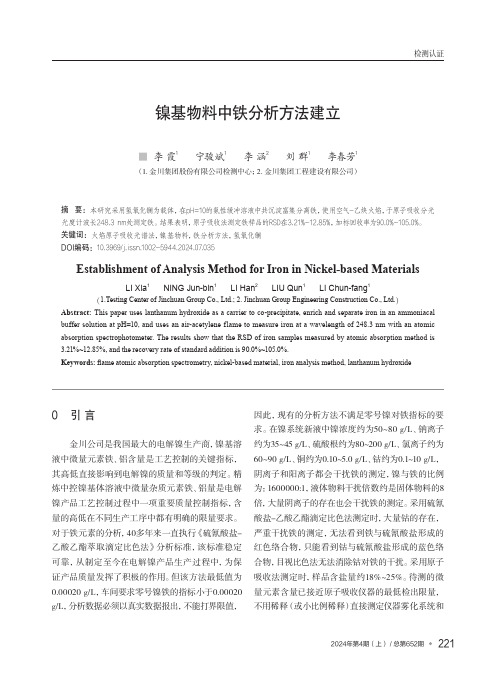
检测认证镍基物料中铁分析方法建立■ 李 霞1 宁骏斌1 李 涵2 刘 群1 李春芳1(1. 金川集团股份有限公司检测中心;2. 金川集团工程建设有限公司)摘 要:本研究采用氢氧化镧为载体,在pH=10的氨性缓冲溶液中共沉淀富集分离铁,使用空气-乙炔火焰,于原子吸收分光光度计波长248.3 nm处测定铁。
结果表明,原子吸收法测定铁样品的RSD在3.21%~12.85%,加标回收率为90.0%~105.0%。
关键词:火焰原子吸收光谱法,镍基物料,铁分析方法,氢氧化镧DOI编码:10.3969/j.issn.1002-5944.2024.07.035Establishment of Analysis Method for Iron in Nickel-based Materials LI Xia1 NING Jun-bin1 LI Han2 LIU Qun1 LI Chun-fang1(1.Testing Center of Jinchuan Group Co., Ltd.; 2. Jinchuan Group Engineering Construction Co., Ltd.)Abstract:This paper uses lanthanum hydroxide as a carrier to co-precipitate, enrich and separate iron in an ammoniacal buffer solution at pH=10, and uses an air-acetylene flame to measure iron at a wavelength of 248.3 nm with an atomic absorption spectrophotometer. The results show that the RSD of iron samples measured by atomic absorption method is 3.21%~12.85%, and the recovery rate of standard addition is 90.0%~105.0%.Keywords: flame atomic absorption spectrometry, nickel-based material, iron analysis method, lanthanum hydroxide0 引 言金川公司是我国最大的电解镍生产商,镍基溶液中微量元素铁、铝含量是工艺控制的关键指标,其高低直接影响到电解镍的质量和等级的判定。
耐腐蚀镍基合金焊接及加工指南
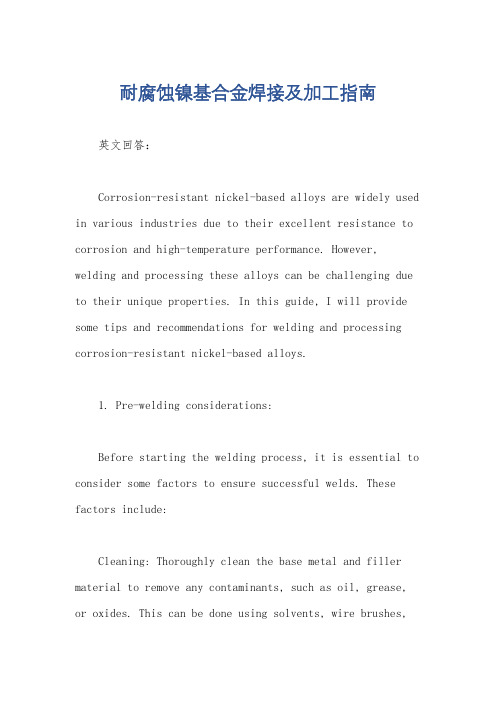
耐腐蚀镍基合金焊接及加工指南英文回答:Corrosion-resistant nickel-based alloys are widely used in various industries due to their excellent resistance to corrosion and high-temperature performance. However, welding and processing these alloys can be challenging due to their unique properties. In this guide, I will provide some tips and recommendations for welding and processing corrosion-resistant nickel-based alloys.1. Pre-welding considerations:Before starting the welding process, it is essential to consider some factors to ensure successful welds. These factors include:Cleaning: Thoroughly clean the base metal and filler material to remove any contaminants, such as oil, grease, or oxides. This can be done using solvents, wire brushes,or chemical cleaning methods.Preheating: Preheating the base metal can help reduce thermal stresses and improve the weldability of the alloy. The preheating temperature will depend on the specific alloy being used.Joint design: Proper joint design is crucial for achieving strong and durable welds. Consider factors like joint type, groove angle, and filler material selection to ensure a sound weld joint.2. Welding techniques:Several welding techniques can be used for corrosion-resistant nickel-based alloys, including:Gas tungsten arc welding (GTAW): Also known as TIG welding, GTAW is commonly used for these alloys due to its precise control and high-quality welds. It requires a skilled operator and is suitable for both thin and thick sections.Gas metal arc welding (GMAW): Also known as MIG welding, GMAW is a popular choice for welding nickel-based alloys.It offers high productivity and is suitable for both manual and automated applications.Plasma arc welding (PAW): PAW is similar to GTAW but uses a more concentrated arc. It provides deeperpenetration and faster welding speeds, making it suitablefor thicker sections.3. Filler material selection:Choosing the right filler material is crucial for achieving strong and corrosion-resistant welds. Some commonly used filler materials for nickel-based alloys include:ERNiCrMo-3: This filler material is suitable forwelding alloys such as Inconel 625 and Incoloy 825. Itoffers excellent corrosion resistance and high-temperature strength.ERNiCr-3: This filler material is commonly used for welding alloys such as Inconel 600 and Inconel 601. It provides good corrosion resistance and is suitable for a wide range of applications.4. Post-welding considerations:After completing the welding process, it is essential to consider post-welding treatments to ensure the best performance of the welds. These treatments may include:Stress relieving: Heat treatment can be applied to relieve any residual stresses in the welds. This is especially important for thick sections or when welding dissimilar alloys.Surface finishing: Proper surface finishing techniques, such as grinding or polishing, can improve the aesthetics and corrosion resistance of the welds.中文回答:耐腐蚀镍基合金由于其出色的耐腐蚀性能和高温性能而被广泛应用于各个行业。
镍基高温合金材料的研究进展

镍基高温合金材料的研究进展一、本文概述镍基高温合金材料作为一种重要的金属材料,以其出色的高温性能、良好的抗氧化性和优异的力学性能,在航空航天、能源、化工等领域具有广泛的应用。
随着科技的快速发展,对镍基高温合金材料的性能要求日益提高,其研究进展也备受关注。
本文旨在全面综述镍基高温合金材料的最新研究进展,包括其成分设计、制备工艺、组织结构、性能优化以及应用领域等方面,以期为未来镍基高温合金材料的进一步发展提供理论支持和指导。
本文首先介绍了镍基高温合金材料的基本概念和特性,概述了其在不同领域的应用现状。
随后,重点分析了镍基高温合金材料的成分设计原理,包括合金元素的选取与配比,以及如何通过成分调控优化材料的性能。
在制备工艺方面,本文介绍了近年来出现的新型制备技术,如粉末冶金、定向凝固、热等静压等,并探讨了这些技术对材料性能的影响。
本文还深入探讨了镍基高温合金材料的组织结构特点,包括相组成、晶粒大小、位错结构等,并分析了这些结构因素对材料性能的影响机制。
在性能优化方面,本文总结了通过热处理、表面处理、复合强化等手段提高镍基高温合金材料性能的研究进展。
本文展望了镍基高温合金材料在未来的发展趋势和应用前景,特别是在新一代航空航天发动机、核能发电、高温传感器等领域的应用潜力。
通过本文的综述,旨在为相关领域的研究人员和企业提供有益的参考和借鉴,推动镍基高温合金材料的进一步发展和应用。
二、镍基高温合金的基础知识镍基高温合金,也称为镍基超合金,是一种在高温环境下具有优异性能的特殊金属材料。
它们主要由镍元素组成,并添加了各种合金元素,如铬、铝、钛、钽、钨、钼等,以优化其热稳定性、强度、抗氧化性、抗蠕变性和耐腐蚀性。
镍基高温合金的这些特性使其在航空航天、能源、石油化工等领域具有广泛的应用。
镍基高温合金之所以能够在高温环境下保持优异的性能,主要得益于其微观结构的特殊性质。
这些合金在固溶处理和时效处理后,会形成一系列复杂的金属间化合物,如γ'、γ''和γ'″等,这些化合物在基体中弥散分布,起到了强化基体的作用。
镍基高温合金的高温氢脆性机制研究与改善

镍基高温合金的高温氢脆性机制研究与改善镍基高温合金是一类在高温环境中具有良好性能的材料,广泛应用于航空航天、能源等领域。
然而,镍基高温合金在高温氢气环境下存在着高温氢脆性问题,大大限制了其应用范围和寿命。
因此,研究镍基高温合金的高温氢脆性机制,并通过改善措施来降低高温氢脆性,具有重要的工程应用意义。
一、高温氢脆性机制的研究高温氢脆性是指在高温环境中,镍基高温合金在受到氢气作用下发生脆性断裂的现象。
研究表明,高温氢脆性的机制主要包括以下几个方面:1. 氢的吸附和扩散:氢在高温气体中往往以原子的形式存在,并能够通过合金的晶界、孔隙等缺陷进入合金内部。
氢原子的吸附和扩散过程决定了其在镍基高温合金中的分布情况,进而影响合金的力学性能。
2. 氢的溶解和聚集:吸附在合金中的氢原子会进一步溶解到合金的晶格中,形成氢原子的固溶体。
当氢含量达到一定程度时,氢原子会聚集,形成氢气泡或氢原子团簇,导致材料内部应力集中,加剧高温氢脆性。
3. 氢的影响:氢原子在高温下与合金中的元素发生复杂的相互作用,影响合金的晶体结构和晶界结合情况。
这些作用包括氢原子与合金中的金属元素形成氢化物、与晶界形成氢化物沉淀等,导致晶体和晶界的稳定性降低,进一步引发高温氢脆性。
二、高温氢脆性的改善措施为了降低镍基高温合金的高温氢脆性,可以采取以下改善措施:1. 合金设计与优化:通过调整合金的化学成分和配比,选择合适的合金元素,可以改善镍基高温合金的高温氢脆性。
例如,控制炭、硼等容易与氢形成氢化物的元素含量,减少氢原子在合金中的溶解和聚集。
2. 晶界工程:晶界是镍基高温合金中最容易发生氢脆的区域。
通过晶界工程技术,可以优化晶界的结构和性质,降低晶界区域的氢脆敏感性。
例如,通过调整晶界的取向和结构,增加晶界的能量和强度,减少氢原子在晶界处的聚集。
3. 表面处理:在镍基高温合金的表面进行特殊处理,形成一层致密、稳定的氧化膜,可以防止氢原子的吸附和扩散。
稳定超疏水镍基涂层的制备及其耐蚀性

第52卷第12期表面技术2023年12月SURFACE TECHNOLOGY·379·腐蚀与防护稳定超疏水镍基涂层的制备及其耐蚀性宋政伟1,黄志凤2,谢治辉2*,丁莉峰1,张胜健1,徐克瑾1,张学元3(1.太原工业学院,太原 030008;2.西华师范大学 化学合成与污染控制 四川省重点实验室,四川 南充 637002;3. GAMRY公司,美国 宾夕法尼亚州 18974)摘要:目的在金属表面制备稳定的超疏水镍基涂层,以提升金属的耐蚀性。
方法通过电沉积方法先后在金属表面获得具有微纳结构的多孔镀镍层和聚硅氧烷层。
通过扫描电子显微镜、X射线粉末衍射仪、X射线光电子能谱、傅里叶变换红外光谱仪、接触角测定仪、电化学工作站等对涂层的形貌、成分、疏水性和耐蚀性进行表征。
结果乙二醇的添加能够促进电镀镍时阴极氢气的析出,当乙二醇的添加量为50.0~100.0 mg/dm3时,形成了均匀相互连接的多孔镍镀层;在水解后的硅氧烷溶液中、-1.5 V电压下沉积3.0 min,可形成具有自清洁性能的超疏水膜层,其表面水接触角达到(159±1)°。
在质量分数为3.5%的氯化钠溶液中,涂层的腐蚀电流密度约为3.6×10-8 A/cm2,与未修饰的镍镀层相比降低了3个数量级;低频阻抗模值|Z|0.01 Hz为2.0× 106Ω·cm2,与未修饰的镍镀层相比,提升了3个数量级;在磨损实验后,涂层的微纳米结构依旧存在,保持着超疏水能力,其腐蚀电流密度和|Z|0.01 Hz分别为5.3×10-8 A/cm2和1.3×106Ω·cm2,说明经磨损后涂层依然具有较好的耐蚀性。
结论通过电沉积和硅氧烷修饰制备的超疏水复合涂层具有稳定超疏水性和优良耐蚀性,能够为基底金属提供良好的防护。
关键词:电镀镍;超疏水涂层;耐蚀性;多孔镍;微纳米结构中图分类号:TG174.4 文献标识码:A 文章编号:1001-3660(2023)12-0379-11DOI:10.16490/ki.issn.1001-3660.2023.12.032Preparation and Corrosion Resistance of RobustSuperhydrophobic Nickel-based CoatingSONG Zheng-wei1, HUANG Zhi-feng2, XIE Zhi-hui2*, DING Li-feng1,ZHANG Sheng-jian1, XU Ke-jin1, ZHANG Xue-yuan3(1. Taiyuan Institute of Technology, Taiyuan 030008, China; 2. Sichuan Provincial Key Laboratory of ChemicalSynthesis and Pollution Control, China West Normal University, Sichuan Nanchong 637002, China;3. Gamry Instruments, Warminster Pennsylvania 18974, USA)ABSTRACT: In nature, the corrosion of most metals is universal and spontaneous, so adequate protection must be carried out for metals in use. The coating is one of the most common ways to metal corrosion, such as metal coating, conversion coating, oxidation coating and superhydrophobic coating. Among these protective coatings, the corrosion metal superhydrophobic coating has great application potential in metal protection. The formation of a layer of air as a barrier between a收稿日期:2022-11-07;修订日期:2023-02-16Received:2022-11-07;Revised:2023-02-16基金项目:国家自然科学基金(52271073);山西省大学生创新创业训练项目(2022)Fund:National Natural Science Foundation of China (52271073); College Student Innovation and Entrepreneurship Training Program of Shanxi (2022)引文格式:宋政伟, 黄志凤, 谢治辉, 等. 稳定超疏水镍基涂层的制备及其耐蚀性[J]. 表面技术, 2023, 52(12): 379-389.SONG Zheng-wei, HUANG Zhi-feng, XIE Zhi-hui, et al. Preparation and Corrosion Resistance of Robust Superhydrophobic Nickel-based Coating[J]. Surface Technology, 2023, 52(12): 379-389.*通信作者(Corresponding author)·380·表面技术 2023年12月superhydrophobic metal substrate and liquid provides remarkable opportunities in corrosion resistance of metal compounds.However, the poor stability of the superhydrophobic coating limits its wide range of applications. This paper aims to prepare robust superhydrophobic nickel-based coatings on a metal surface to improve corrosion resistance.The brass sheet was cut into a rectangle of 20 mm⨯20 mm as the substrate. A composite coating including a micro/nanostructured porous nickel-plated layer and a polysiloxane layer was prepared on the brass surface via a three-step deposition protocol. In the first stage, the nickel-plated layer with a microporous structure was formed on the brass surface by electroplating in a nickel-plating bath with the addition of ammonium chloride and ethylene glycol. After that, the sample was electrodeposited in another nickel-plating solution containing crystal regulator ethylenediamine hydrochloride to form a sea urchin-like nickel layer. Finally, a polysiloxane layer was deposited on the surface by electrodeposition to obtain a coating with durable superhydrophobic properties. The morphology, composition, hydrophobicity, and corrosion resistance of the coating were characterized with a scanning electron microscope (SEM), an X-ray powder diffractometer (XRD), an X-ray photoelectron spectroscopy (XPS), a Fourier transform infrared spectroscopy (FT-IR), a contact angle tester, and an electrochemical workstation. The mechanical stability of the prepared superhydrophobic coating was characterized by a linear wear test on an 800-grit sandpaper with a 200.0 g weight load.The results showed that the adding ethylene glycol in a nickel-plating bath promoted the evolution of hydrogen in the cathode during electroplating, and a uniformly connected porous nickel coating was formed when the addition amount of ethylene glycol was 50.0-100.0 mg/dm3. After two-step nickel electroplating, a nickel layer with a sea urchin-like structure was formed on the brass surface. A self-cleaning and superhydrophobic layer with a water contact angle of (159±1)° was formed by electrodeposition in the hydrolyzed silane solution under a voltage of -1.5 V for 3.0 min. In the 3.5% NaCl solution, the corrosion current density of the as-prepared composite coating was about 3.6×10-8 A/cm2, reduced by three orders of magnitude compared with the unmodified nickel coating. Additionally, the impedance modulus at a low-frequency (|Z|0.01 Hz) was around2.0×106Ω·cm2, increased by three orders of magnitude compared with the unmodified nickel coating.After the wear test, the micro/nanostructured surface existed, which kept the superhydrophobicity of the coating (contact angle above 150°). Besides, the corrosion current density and |Z|0.01 Hz of the composite coating after wear were 5.3×10-8 A/cm2 and 1.3×106Ω·cm2, respectively, indicating that good corrosion resistance of the coating was remained.The as-prepared superhydrophobic composite coating by simple electrodeposition and silane modification has a robust superhydrophobic capability and excellent corrosion resistance, which provides good protection for the substrate metal.KEY WORDS: electro-plating nickel; superhydrophobic coating; corrosion resistance; porous nickel; micro/nano structure腐蚀是导致金属失效的主要原因之一,据统计,腐蚀每年造成的直接经济损失占国内生产总值的3%左右[1]。
镍基合金激光熔覆研究进展及其在反应堆的应用展望
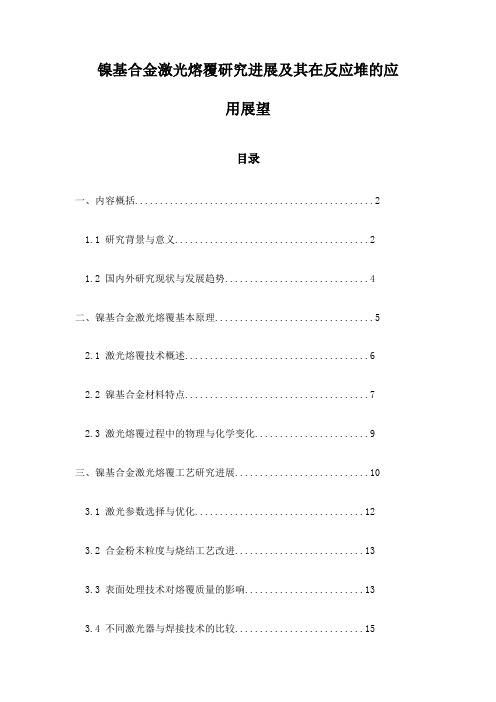
镍基合金激光熔覆研究进展及其在反应堆的应用展望目录一、内容概括 (2)1.1 研究背景与意义 (2)1.2 国内外研究现状与发展趋势 (4)二、镍基合金激光熔覆基本原理 (5)2.1 激光熔覆技术概述 (6)2.2 镍基合金材料特点 (7)2.3 激光熔覆过程中的物理与化学变化 (9)三、镍基合金激光熔覆工艺研究进展 (10)3.1 激光参数选择与优化 (12)3.2 合金粉末粒度与烧结工艺改进 (13)3.3 表面处理技术对熔覆质量的影响 (13)3.4 不同激光器与焊接技术的比较 (15)四、镍基合金激光熔覆的组织与性能研究 (16)4.1 熔覆层微观组织形貌分析 (17)4.2 熔覆层力学性能测试与评价 (19)4.3 熔覆层耐腐蚀性能研究 (20)4.4 熔覆层高温性能评估 (21)五、镍基合金激光熔覆在反应堆中的应用展望 (22)5.1 反应堆冷却剂系统材料选择 (24)5.2 反应堆结构材料激光熔覆修复技术 (25)5.3 反应堆安全屏障材料研发与应用 (26)5.4 激光熔覆技术在反应堆驱动冷却系统中的应用 (28)六、镍基合金激光熔覆面临的挑战与对策 (29)6.1 生产成本与工艺稳定性问题 (30)6.2 熔覆层长期性能评估与验证 (32)6.3 安全性评估与监管政策完善 (33)6.4 人才培养与技术研发团队建设 (34)七、结论与展望 (36)7.1 研究成果总结 (36)7.2 未来发展方向与趋势预测 (37)一、内容概括镍基合金激光熔覆技术因其能够有效提升材料性能、降低制造成本和加工复杂度的优势,在诸多领域得到了快速发展。
尤其是在反应堆领域,镍基合金激光熔覆有望为延长堆芯寿命、提高安全性以及降低维护成本等方面提供有效的解决方案。
本文首先综述了镍基合金激光熔覆的基础原理和技术特点,详细介绍了国内外学者近年来在激光熔覆过程优化、熔覆体系设计和性能评价等方面的研究进展。
接着,针对反应堆的具体应用需求,分析了不同种类的镍基合金激光熔覆材料在堆芯组件、管道、热结构等方面的优势及应用前景。
镍基双金属或多元金属合金催化剂_解释说明以及概述
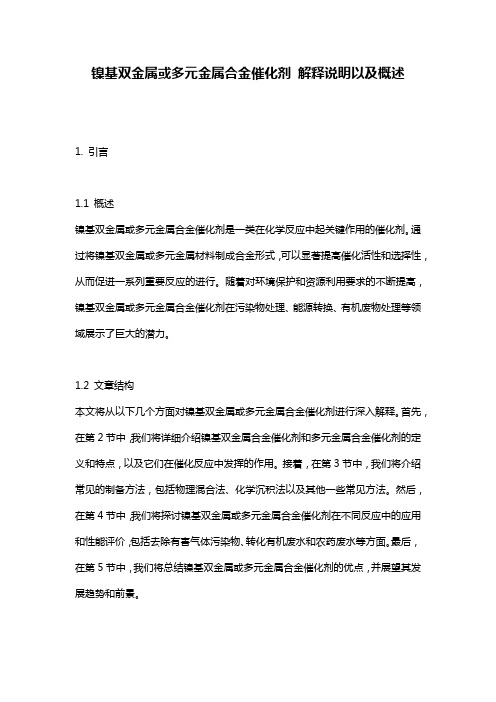
镍基双金属或多元金属合金催化剂解释说明以及概述1. 引言1.1 概述镍基双金属或多元金属合金催化剂是一类在化学反应中起关键作用的催化剂。
通过将镍基双金属或多元金属材料制成合金形式,可以显著提高催化活性和选择性,从而促进一系列重要反应的进行。
随着对环境保护和资源利用要求的不断提高,镍基双金属或多元金属合金催化剂在污染物处理、能源转换、有机废物处理等领域展示了巨大的潜力。
1.2 文章结构本文将从以下几个方面对镍基双金属或多元金属合金催化剂进行深入解释。
首先,在第2节中,我们将详细介绍镍基双金属合金催化剂和多元金属合金催化剂的定义和特点,以及它们在催化反应中发挥的作用。
接着,在第3节中,我们将介绍常见的制备方法,包括物理混合法、化学沉积法以及其他一些常见方法。
然后,在第4节中,我们将探讨镍基双金属或多元金属合金催化剂在不同反应中的应用和性能评价,包括去除有害气体污染物、转化有机废水和农药废水等方面。
最后,在第5节中,我们将总结镍基双金属或多元金属合金催化剂的优点,并展望其发展趋势和前景。
1.3 目的本文的目的是对镍基双金属或多元金属合金催化剂进行全面解释和概述,以帮助读者了解其定义、特点、制备方法以及在不同反应中的应用和性能评价。
通过深入研究该类催化剂,我们希望能够探索其潜力,并为未来的相关研究提供参考和指导。
2. 镍基双金属或多元金属合金催化剂解释说明:2.1 镍基双金属合金催化剂的定义和特点:镍基双金属合金催化剂是一种由镍及其他一种或多种金属组成的材料,其结构中含有两种或多种不同的金属元素。
这些合金催化剂通常具有高度的催化活性和选择性,在众多领域中被广泛应用。
镍基双金属合金催化剂的特点主要包括以下几个方面:- 增强催化活性:通过与不同类型的金属形成合金结构,镍基双金属合金催化剂能够增加表面活性位和吸附能力,从而提高催化反应速率。
- 提高稳定性:镍作为常见的过渡金属之一,具有良好的耐腐蚀和稳定性。
与其他合金元素形成双金属结构后,可以进一步增强材料的稳定性和抗烧结能力。
镍基催化剂 综述
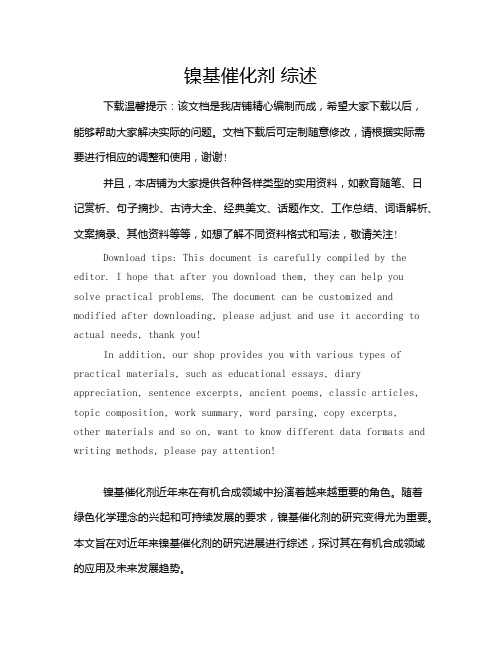
镍基催化剂综述下载温馨提示:该文档是我店铺精心编制而成,希望大家下载以后,能够帮助大家解决实际的问题。
文档下载后可定制随意修改,请根据实际需要进行相应的调整和使用,谢谢!并且,本店铺为大家提供各种各样类型的实用资料,如教育随笔、日记赏析、句子摘抄、古诗大全、经典美文、话题作文、工作总结、词语解析、文案摘录、其他资料等等,如想了解不同资料格式和写法,敬请关注!Download tips: This document is carefully compiled by the editor. I hope that after you download them, they can help yousolve practical problems. The document can be customized and modified after downloading, please adjust and use it according to actual needs, thank you!In addition, our shop provides you with various types of practical materials, such as educational essays, diary appreciation, sentence excerpts, ancient poems, classic articles, topic composition, work summary, word parsing, copy excerpts,other materials and so on, want to know different data formats and writing methods, please pay attention!镍基催化剂近年来在有机合成领域中扮演着越来越重要的角色。
2024年高性能铜镍合金带、线材相关项目实施方案

汇报人: 2024-01-31
目录
• 项目背景与目标 • 技术方案与工艺流程 • 生产组织与管理体系建设 • 市场推广与销售策略部署 • 风险防范措施与应急预案制定 • 项目进度安排与资源保障措施
01
项目背景与目标
市场需求及发展趋势
市场需求
随着电子、通讯、航空航天等行 业的快速发展,对高性能铜镍合 金带、线材的需求不断增长。
资金筹措渠道和使用监管机制建立
要点一
资金筹措渠道
要点二
使用监管机制建立
分析项目资金需求,制定资金筹措计划,包括自筹资金、 银行贷款、政府补助等多元化渠道筹措资金。
建立严格的资金使用监管机制,确保资金专款专用、合规 使用;同时加强内部审计和财务公开,接受各方监督。
THANKS
感谢观看
建立技术风险防控体系,制定严格的技术标准 和操作规范。
针对可能出现的技术问题,制定相应的解决方 案和应对措施,确保项目技术方案的可行性和 可靠性。
市场波动风险预测和应对措施
对市场进行深入调研,了解市场动态和价格波动趋势 。
建立市场波动风险预测模型,对市场波动进行量化分 析和预测。
制定灵活的市场应对策略,包括调整产品定价、优化 销售策略等,以应对市场波动带来的风险。
关键节点时间表
包括项目启动、研发、试验、生产、测试、市场推广等关键节点的时间安排,确保项目按计划推进。
里程碑事件明确
设定项目实施过程中的重要里程碑事件,如技术突破、产品定型、产能达标等,以便及时评估项目进 展和成果。
人力资源需求分析和招聘培训计划
人力资源需求分析
根据项目目标和任务,分析所需人员的数量、技能和经验等要求,为招聘和培训提供依据。
镍基废料处理成分复杂的废料的其它方法
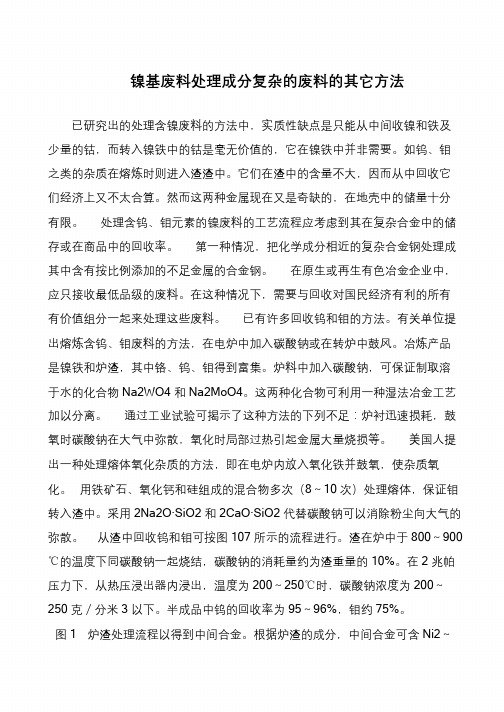
书山有路勤为径,学海无涯苦作舟镍基废料处理成分复杂的废料的其它方法已研究出的处理含镍废料的方法中,实质性缺点是只能从中间收镍和铁及少量的钴,而转入镍铁中的钴是毫无价值的,它在镍铁中并非需要。
如钨、钼之类的杂质在熔炼时则进入渣渣中。
它们在渣中的含量不大,因而从中回收它们经济上又不太合算。
然而这两种金属现在又是奇缺的,在地壳中的储量十分有限。
处理含钨、钼元素的镍废料的工艺流程应考虑到其在复杂合金中的储存或在商品中的回收率。
第一种情况,把化学成分相近的复杂合金钢处理成其中含有按比例添加的不足金属的合金钢。
在原生或再生有色冶金企业中,应只接收最低品级的废料。
在这种情况下,需要与回收对国民经济有利的所有有价值组分一起来处理这些废料。
已有许多回收钨和钼的方法。
有关单位提出熔炼含钨、钼废料的方法,在电炉中加入碳酸钠或在转炉中鼓风。
冶炼产品是镍铁和炉渣,其中铬、钨、钼得到富集。
炉料中加入碳酸钠,可保证制取溶于水的化合物Na2WO4 和Na2MoO4。
这两种化合物可利用一种湿法冶金工艺加以分离。
通过工业试验可揭示了这种方法的下列不足:炉衬迅速损耗,鼓氧时碳酸钠在大气中弥散,氧化时局部过热引起金属大量烧损等。
美国人提出一种处理熔体氧化杂质的方法,即在电炉内放入氧化铁并鼓氧,使杂质氧化。
用铁矿石、氧化钙和硅组成的混合物多次(8~10 次)处理熔体,保证钼转入渣中。
采用2Na2O·SiO2 和2CaO·SiO2 代替碳酸钠可以消除粉尘向大气的弥散。
从渣中回收钨和钼可按图107 所示的流程进行。
渣在炉中于800~900 ℃的温度下同碳酸钠一起烧结,碳酸钠的消耗量约为渣重量的10%。
在2 兆帕压力下,从热压浸出器内浸出,温度为200~250℃时,碳酸钠浓度为200~250 克/分米3 以下。
半成品中钨的回收率为95~96%,钼约75%。
图1 炉渣处理流程以得到中间合金。
根据炉渣的成分,中间合金可含Ni2~。
- 1、下载文档前请自行甄别文档内容的完整性,平台不提供额外的编辑、内容补充、找答案等附加服务。
- 2、"仅部分预览"的文档,不可在线预览部分如存在完整性等问题,可反馈申请退款(可完整预览的文档不适用该条件!)。
- 3、如文档侵犯您的权益,请联系客服反馈,我们会尽快为您处理(人工客服工作时间:9:00-18:30)。
扩产
瑞浦
40万吨炼钢
40万吨不锈钢棒材和 25万吨不锈钢线材
无
泰郎
2.5万吨300系 列
无缝钢管
无
上海生产基地
主要制程: 不锈钢长材冷加工 产能
产品
不锈钢
6万吨
钢管和管件
扩产
无
上海鼎信不锈钢工业园
钢管
海外投资
• 印尼苏拉威西采矿 • 印尼兴建镍基料生产厂 • 非洲投资铬矿和铬铁厂
2013年生产目标 3百万吨不锈钢
• 受到相对比较好的利润驱动, 镍基料年增长率超过50%
• 许多新的电炉和RKEF成为了新 的主要的产能扩张.
•以10%Ni含量的镍基料为例,估 计在2013年3月的时候,月度供 应总量已经达到3.5万吨纯镍当 量,然而中国主要的钢厂的镍基 料纯镍当量需求仅为3.2万吨, 供大于求已经发生。
Source: Metalligence China
-2012年中国500强企业排名285位,2012年中国民营企业500强排名46位。
青山在2011年位居世界第七大不锈钢制造商,预估2012年将位居前5名。 资料来源: SMR, 基于2011年的数字
青山钢铁的历史和里程碑
敢为天下先
1992
中国首家使用AOD炼钢的 民营不锈钢公司
2004
中国首家具有连铸能力的民营不 锈钢公司
• 2014年镍价可能会上涨.
• 镍矿进口可能会减少,并且国内的镍 基料生产商可能在消耗完高镍库存后 面临高镍矿供应的难题。中国镍矿进 口商会去其他地方寻找高镍矿资源。 中国主要的不锈钢生产商可能会大幅 增加精炼镍的进口,比如镍铁。
• 随着更多的镍基料厂在印尼的投资,
镍基料可能在世界范围内开始流行使
• 与伦敦镍价相比,目前中国不锈钢生 产商和消费商在制定销售价格和采购价 格时更多的会考虑镍基料价格的趋势和 波动幅度。
•中国304不锈钢价格与镍基料的变化趋 势更接近。
•目前,LME的镍价对中国不锈钢市场 价格的影响更多的是在心理影响,而非 实际的作用。
镍基料: 中国不锈钢制造商的命根子
1.8%镍含量的镍矿价格和LME渐行渐远
8万吨镍
镍基料: 中国不锈钢生产商的命根子
镍基料给中国不锈钢生产商带来了很大的成本优势和供应的稳定性
• 通常国内镍价和LME的镍价在一年的 95%的时间里有平均约600美金的价差。 • 与国内镍价格相比,镍基料更便宜。 • 与其他任何镍原料相比,镍基料拥有 不可比的拟压倒性优势。
中国不锈钢厂的原料上使用时的主要做法: 尽可能减少纯 在印尼和菲律宾投资镍基料生产厂 – 将低含量镍基料精炼成不锈钢基料 – 开发新的利用低品位红土镍矿的工艺 – 一体化热装热送到不锈钢生产
中国镍基料市场的挑战和机遇
镍基料产能扩张过快导致供大于求
Ni weight(KMT)
600
NPI Consumption
500 500
400
300
200
100
镍基料
不锈钢炼钢
热轧钢卷
广东生产基地
镍基料 不锈钢
主要工艺制程: RKEF+不锈钢炼钢 + 板坯连铸
产能
产品
扩产
60万吨 100万吨
9%~12%F镍基料
200系列/300系列钢带/ 钢坯
无 100万吨
镍基料
不锈钢炼钢 钢坯
浙江生产基地
主要工艺制程: 不锈钢炼钢+连铸+长材热轧
棒材
线材
管材
产能
产品
印尼原矿出口禁令可能带来的影响-(这是笔者的个人看法,不代表公司的立场)
印尼
•矿业法中的可能的漏洞会允许矿商在 2014年继续保持运营,同时产生国家的税 收资金。 (政府计划在2013年可以从整个 矿业产生约82亿美金的税收.)
• 允许矿产有限的继续出口.
•增加出口税率.
•对那些没有在2014年前提交建厂计划的 矿商,将禁止出口。
• 镍矿的价格更加反映了实际的基本面 供需。 • 镍矿价格主要是供需双方商谈的价格。
•与镍价相比,镍矿价格更具稳定性。
镍基料: 中国不锈钢制造商的命根子
镍基料的价值链
举例: 内蒙古镍基料(11%镍含量)
中国镍基料市场的挑战和机遇 挑战
– 镍基料供过于求 – 更高的环保要求 – 成本上升的压力(电/煤/运输) – 与钢厂议价时的劣势 – 更多在边际成本线附近生产的机会
2010
中国首家RKEF镍基料生产线。
世界首家镍基料不锈钢热送生产 300系不锈钢
2012
• 中国最大的镍铁电炉60MVA投产
• 中国第一家利用镍铁生产余热发电的 公司
1992
2002
1998
• 世界首创移动式AOD生产炼钢方式
2008
2010
2009
中国首家在印尼成功投资大型红土镍矿的民 营公司
2011
中国首家拥有2艘5万吨远洋镍矿运输船只的 民营不锈钢公司.
中国的主要生产基地
福建生产基地
主要工艺制程: RKEF+不锈钢炼钢+热轧
镍基料 不锈钢
产能
30万吨/年 60万吨
产品
扩产计划
9%~12%镍基料
年产50-80万吨200系列 不锈钢使用的镍基料
300系列钢卷
年产150万吨200系列
青山福安工厂的纯镍使用比率
• 目前青山福安工厂月产5万吨左右300 系列不锈钢,原生镍的需求是3600吨。 •2012年,月均使用纯镍300吨。 •2013年,月均使用纯镍50吨。
镍基料: 中国不锈钢制造商的命根子
与纯镍的相关性相比,中国304市场的价格与镍基料的价格更具相关性。
304不锈钢,纯镍和镍基料的价格相关性
75
360 272 198 111
0 Y2008
Y2009
Y2010
Y2011
Y2012 Y2013(f)
镍基料是最好的不锈钢冶炼的镍原料.
Source: Tsingshan Market Research
Source: Macquarie Research
中国镍基料市场的挑战和机遇
中国镍基料产能激增-从2012年开始发生产能过剩-(这是笔者的个人看法,不代表公司的立场)
镍基料 – 永续的解决方案?
吴艳军
2013年6月 高雄
主要内容 1 青山简介
2 镍基料: 中国不锈钢制造商的命根子 3 中国镍基料市场的挑战与机遇 4 印尼原矿出口禁令的影响 5 镍原料供应的长期战略
青山钢铁简介
中国最大的民营不锈钢企业 -2012年业绩:
• 不锈钢粗钢产量: 225万吨 + 36% • 镍金属产量: 52,000 吨 (来自镍料当中的纯镍) + 73% • 销售收入: 66亿美金 + 31%
